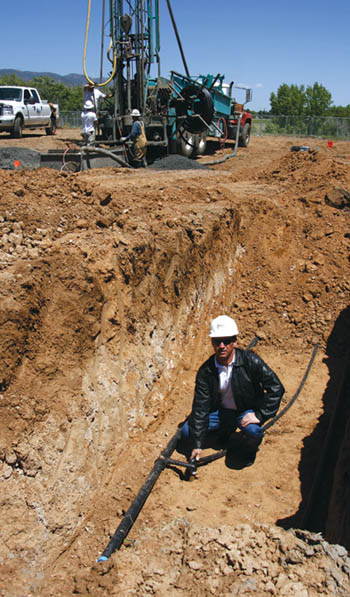
That's because most of the piping and related hardware will either be underground outside the buildings or above the ceilings inside.
A recent visit to the Holmes site brought explanations of how a system of fluids (70 percent water and 30 percent food-grade propleyene) running repeatedly through a pipe loop can provide both heating and cooling to a school.
In the summertime, said Rick LaRose, the Holmes project manager, the heat inside the buildings is picked up by the fluid and is then cooled as it circulates through the outside pipes, which are several hundred feet under the ground (where the temperature is always close to 50 degrees).
“In the winter it's just the opposite,” he said. “The heat from the earth uses the water to carry it into the building and then into the air.” Inside, there are also 64 electronically operated heat pumps that help increase the 50 degrees to 70 degrees, he added.
Other efficiencies come from roof “ventilators” that are designed to “grab the energy from the air leaving the building,” LaRose said. Another such feature is the way hot and cold pipes run next to each other in places - the idea being to moderate each other's temperatures, said Stephen Roitsch of Farris Engineering, which did the system design work at both Holmes and Washington.
The entire system is electrically powered, no longer requiring gas to power huge boilers, as before. There is a higher up-front installation cost than for conventional air- conditioning and an increase in the school's electrical usage, but overall the system will produce four times as much energy as is put into it, according to Roitsch.
District 11 is familiar with geothermal heating/ cooling, having been one of the first entities in the region to install such a system for its then-new Facilities Operations Center in 1998.
“There is a long-term value,” LaRose said.
One unavoidable reality is that a power outage would prevent the system from working, but that's no different than with boilers, which also require electricity to function, Foitsch noted.
Could the liquid in the pipes ever freeze if the fluid stayed inert long enough? To do so, the insides of the buildings would have to get down to the highly unlikely level of 15 below zero, said Mike Everett, owner of Rocky Mountain Geo-thermal from Centennial, Colo., which is drilling and installing the pipe system underneath a softball practice field just east of the Holmes school buildings.
Two of Everett's drilling rigs have been busy at Holmes since May (even before school let out), en route to creating 112 holes, 300 feet deep. On their way to the 300-foot depth, Everett's crews typically hit 60 feet of loose gravel and a few hard ledges of sandstone at about 260 feet. The majority is shale and clay, he said.
Down each hole goes a one-inch-diameter “loop pipe” that will carry the fluid down and back. The holes are drilled in line with each other so that each loop pipe can be connected in a straight line with a two-inch-diameter supply/return pipe that's parallel to the surface and about six feet below it. That way, if any of the holes' loop pipes fail, that line can be shut off for repairs while the rest of the system keeps running, LaRose pointed out.
A treat for school staff will be the ability to adjust the temperature in multiple zones within the buildings, with the help of units called heat pumps. Currently, buildings have a single thermostat, which often means the sunny side is too hot and the shady side is too cold.
Both the Holmes and Washington geothermal installations are part of major building renovations that are being funded by a school district capital improvements bond issue that passed in 2005. Both geothermal projects are due for completion when students return for classes in mid-August.
The Holmes work (priced at $3.164 million) will also include electrical system upgrades, new windows and asphalt, as well as new carpet and lockers, which will be added later in the school year.
Washington ($1.674 million) is also getting fire-rated corridors, direct access to each classroom, new lighting, celings, and upgraded systems for alarm, voice, data, TV and intercom, plus new playground equipment.
Westside Pioneer article